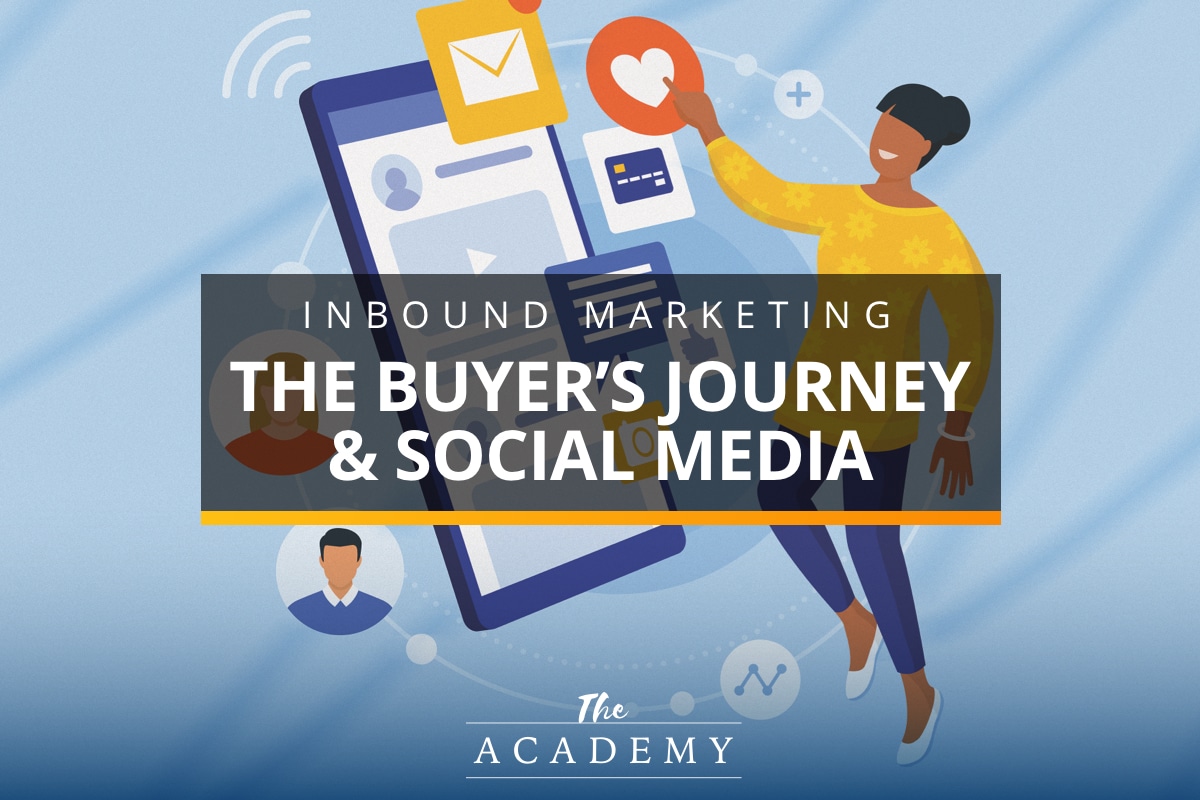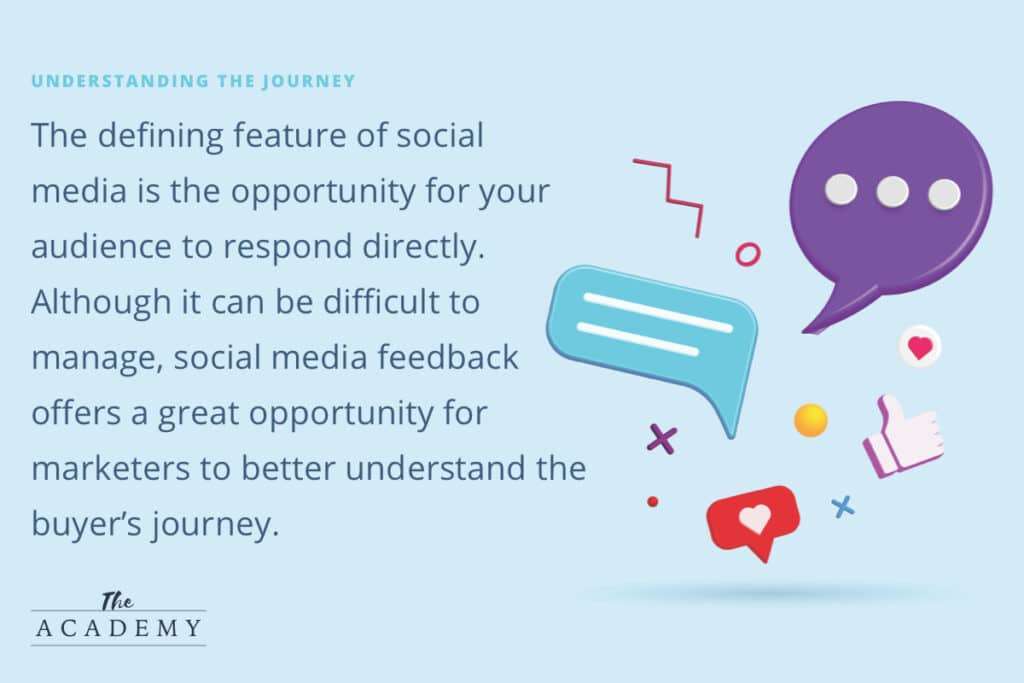
The buyer’s journey is a fundamental concept in marketing. In most cases, when talking about any product or service of at least modest value, potential buyers are not going to make a purchase immediately upon their first interaction with a brand. Rather, there is a journey that must be completed, with a few different steps along that path commonly completed before any money changes hands.
While it would be a bit of an oversimplification, you could say that the primary goal of any marketing department is to move people through the buyer’s journey from start to finish (of course, this leaves out lead generation, which is another hugely important piece, but that’s a conversation for another article).
In this article, we are going to focus on the role that social media can play in moving leads through the buyer’s journey so you can make as many sales as possible. The application of these concepts will vary a bit from one company to another, but you should be able to dial in your system with a bit of testing and experimentation. Let’s dive in!
Stages of the Buyer’s Journey
It’s important that we are on the same page with regard to the concept of the buyer’s journey before we go any further. Only when you have a clear picture of what the buyer’s journey is—and how it works in your business—will you be able to effectively leverage social media to your advantage.
While it’s possible to make the buyer’s journey quite complicated and detailed, it’s easy enough to think of it as including three main stages:
- Awareness. This is when a potential customer first becomes aware of your brand. This individual (or another business) has identified a specific problem and they are out in the marketplace looking for a solution to that problem. Somewhere along the way, they have become aware of your brand. Of course, it is likely that they will also become aware of several other brands at this stage, so you will need to overcome that competition before a sale can be secured.
- Consideration. A little further along the journey, the potential buyer now has a pretty good idea of the various options available and is starting to consider which one will be the best option for their situation. It should be noted that the various options under consideration might not all match up as the same type of product or service. For example, one option might be to completely replace something they own that has broken down, while another option would be to have that item repaired. The consideration stage includes not only the weighing of various companies to work with, but also various types of solutions that can be used.
- Decision. This is when the choice is made and money changes hands. Everything you do in the buyer’s journey process is going to be directed toward reaching this point with as many potential customers as possible. You’ll never get every lead to convert into a sale, of course, and depending on your industry, that conversion rate might actually be quite low. That is especially true if you are selling products or services with a big price tag – expensive items always convert poorly. That’s okay, as long as you bring sufficient leads into the buyer’s journey, the ones that come out the other end as customers will make it all worth it.
One common mistake made by businesses is to assume that the buyer’s journey will just happen. The thinking goes that if you bring in enough leads, some of the leads will naturally become customers, and you’ll be all set. In this line of thinking, the only thing that matters is the volume of leads, and the rest of the journey is left to chance. As you might guess, that is a mistake. Guiding the buyer through the journey intentionally by using a variety of strategic methods is going to boost your results dramatically.
The Importance of Repeat Engagement
Turning our attention specifically to social media, we can see how these platforms can be excellent opportunities to engage with potential customers at various stages of the buyer’s journey. One of the many things that are valuable about social media (in addition to its massive reach) is how you can repeatedly engage with leads over and over again. That’s an opportunity that is hard to find with other types of marketing endeavors, so it’s worth your time to build an audience for your social accounts.
Let’s walk through a hypothetical situation to see how this can play out in practice. Imagine an individual who needs to buy a specific type of product in your geographic area. That person searches for something like “product in [city]” and gets a list of results. As they start to review the options, they stumble onto your social media accounts and follow one of them. Suddenly, a new lead is not only becoming aware of your brand and showing interest, but they have agreed to regularly see new marketing messages from you via social media. That’s an incredible opportunity and one that should not go to waste.
While it’s a great thing to bring in leads like this, there is also a bit of a problem – your various social media followers are sure to be at varied points in the buyer’s journey. Some of these followers will be nearing the point of making a decision, while others will just be gathering market awareness and building the foundation for a purchase later on. Dealing with this problem is as simple as posting assorted types of content to your accounts so there is a little bit of something for everyone.
- People in the awareness stage need information more than anything else. You want to position your brand as an expert in this field, and as a trusted advisor. So, posting free informational content is a good way to boost your authority in the eyes of the audience. Create guides—either written or video, or both—that explain how to use certain products, how to solve common problems, etc. This type of content tends to do really well and it will help to solidify the stature of your brand in the market.
- Those who are in the consideration stage want to know what makes you better than the competition. You will need to get creative with ways to demonstrate what makes you the best option without directly criticizing your competitors. Make it a point to highlight specific features of your products or services that are unique in the market. It would be tempting to compete only on price at this stage, but don’t fall into that trap – more than anything else, potential buyers at the consideration stage of the journey just want to know that they are picking the best option.
- Followers on social media who are ready to make a purchase just need one last push to do so. Often, that will come in the form of a special offer or promotion. On the simple side, you could just post a discount code to your social accounts that offers 10% off or something similar. If someone has been thinking about making a purchase and they see this offer come through their feed, that might be all it takes to finally close the deal. A promotion doesn’t always have to be a discount, however, as you could choose to instead keep the price the same but add on some bonus offer that will give the buyer more for their money. Think about what makes the most sense for your business and experiment with various ideas to see what works.
Building and Leveraging Customer Trust
Trust always goes a long way toward getting people to the end of the buyer’s journey. This is particularly true with higher ticket items. People want to spend their money with a company that they feel they can trust. Social media is helpful in this area, as well, as people can see how you deal with existing customers out in the open.
For instance, if you get a complaint on one of your social accounts, make a point to respond to it quickly and do so in a fair, professional manner. Ignoring negative comments, or arguing with them, is only going to put doubts in the minds of your potential future customers about whether or not they should trust you with a purchase.
Interaction Helps You Understand the Journey
The defining feature of social media that sets it apart from other marketing platforms is the opportunity for your audience to respond directly—and immediately. If you think about it, this is a big departure from basically every advertising platform to come before. When a business runs an ad on TV, for example, the audience that views the ad could talk back to the TV, but no one will hear what they have to say. Although it can be difficult to manage and sometimes frustrating, social media feedback offers a great opportunity for marketers to better understand the buyer’s journey.

Anytime you post content that is in some way promotional, be sure to carefully read the comments on those posts to look for any kinds of trends. Are people commenting that they need to know more about the products you offer? Do they have complaints about the price? Digging through these details can help you understand what is holding some of your audience back from becoming customers.
Obviously, you don’t have to take action on every single piece of feedback you receive. People always want prices to be lower, so only take those kinds of comments seriously if they are overwhelming in volume and there seem to be competitors in the market offering better prices. Otherwise, simply use what you hear from your audience as constructive criticism and as a meaningful opportunity to reduce the hurdles that trip people up on their way to a purchase.
Optimizing the buyer’s journey is a big step in the right direction when trying to maximize the return you get from your marketing efforts. It’s hard enough to bring leads into your funnel, so you want to make sure as many of those leads find their way to the bottom of the funnel as possible. We hope these social media concepts will help you drive people along the right path so you can up your conversion rate and boost your revenues as a result. Good luck!
Most Popular Articles

Seeing Favicons in Your Google Search Results? Here’s Why…
Have you noticed anything different in your Google Search results lately? Google added tiny favicon icons to its organic search results in January. It was…

Business Growth and Digital Marketing News & Tips 11-17-24
Are you encouraging and rewarding innovation? Lee Cockerell is the former Executive Vice President of Operations at Walt Disney World. A lover of traditional red…

Business Growth and Digital Marketing News & Tips 11-27-24
A culture of gratitude "Feeling gratitude and not expressing it is like wrapping a present and not giving it." – William Arthur Ward Beyond being…








